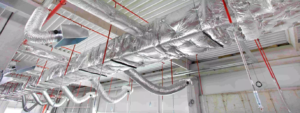What are Flexible Ducts?
Flexible ducts, also known as flexible ducts or flexible air ducts, are a type of ductwork used in HVAC systems. They are constructed from flexible materials that allow them to be bent and maneuvered around obstacles, unlike rigid ducts which require a more permanent and straight installation.
Here are some key characteristics:
-
Material:
- Typically made from plastic or fabric materials with a wire reinforcement for added strength and to maintain their shape.
- Some may have aluminum insulation layers or even fiberglass insulation added for better thermal performance.
-
Benefits:
- Easy installation: Their flexibility allows for easier installation in tight spaces, around corners, or when connecting rigid ducts to registers or diffusers.
- Reduced labor costs: Faster installation due to easier maneuvering compared to rigid ducts.
- Less material waste: It can often be configured to fit existing spaces, reducing the need for cutting and discarding excess material.
- Vibration absorption: Can help dampen vibrations from the HVAC system compared to rigid metal ducts.
-
Limitations:
- Lower airflow capacity: Compared to rigid ducts, flexible ducts can have higher friction losses due to their inner surface texture, which can restrict airflow.
- Prone to sagging: If not properly supported, It can sag and restrict airflow over time, especially over long distances.
- Susceptible to punctures: More vulnerable to physical damage compared to rigid ducts.
- Reduced noise dampening: Generally less effective at dampening noise compared to insulated rigid ducts.
-
Applications:
- Short connections: Often used for short runs connecting rigid duct sections or connecting to registers and diffusers.
- Tight spaces: Suitable for situations where rigid ducts would be difficult to install due to space constraints or obstacles.
- Vibration isolation: Can be beneficial in applications where noise and vibration reduction is a concern.
Here are some additional points:
- Sizing: It’s crucial to choose the correct size to ensure proper airflow and avoid pressure drops in your HVAC system.
- Installation: Proper installation techniques are essential to prevent sagging, ensure optimal airflow, and maintain the integrity of the duct. Consulting an HVAC professional for installation is recommended.
- Cleaning: Flexible ducts can trap dust and debris over time. Regular cleaning following manufacturer’s recommendations is important to maintain good indoor air quality.

